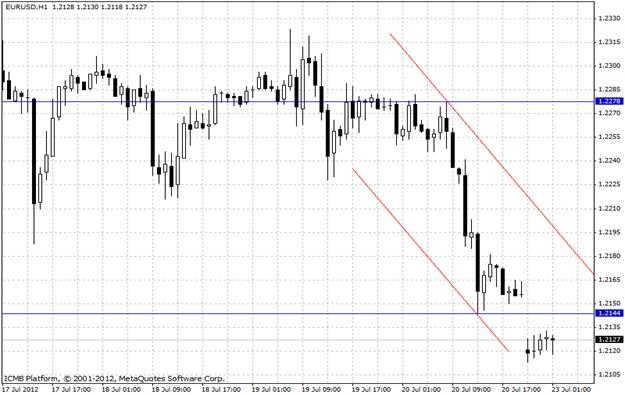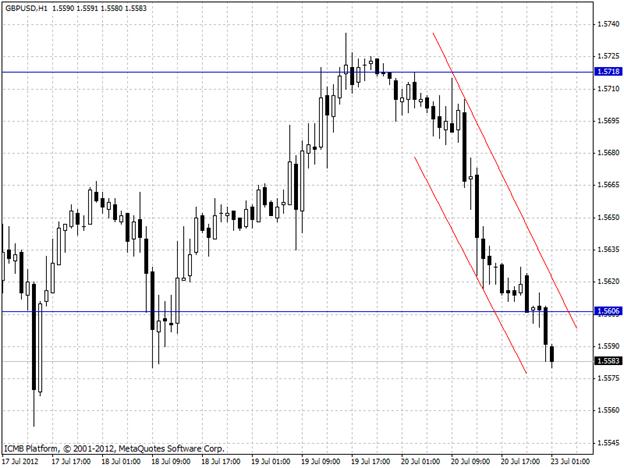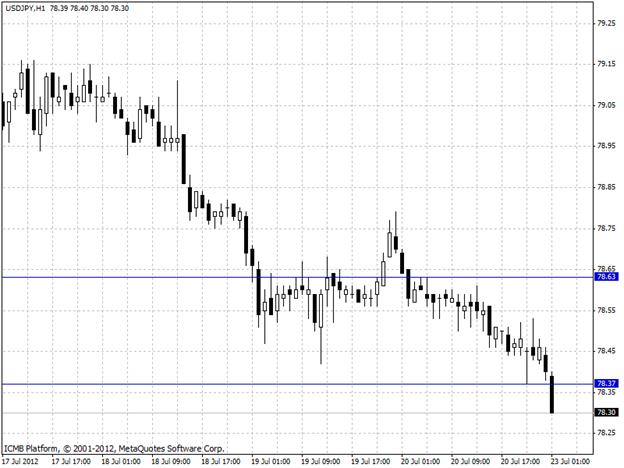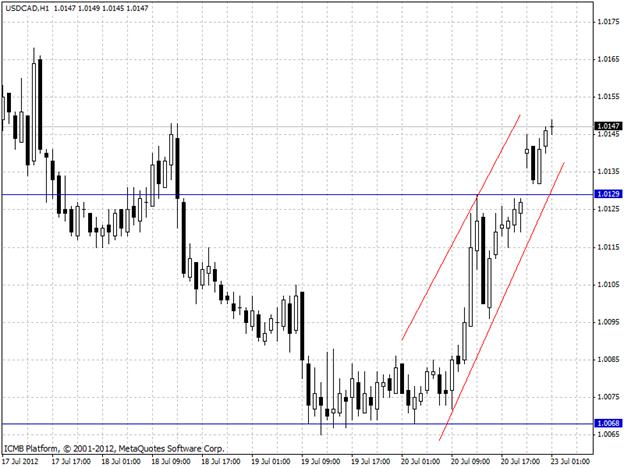The Spanish government cuts economic forecast and sees recession will extend until next year as it adopts more austerity measures. The government expected the economy to shrink 0.5 percent in 2013 in contrast to its earlier forecast for a growth of 0.2 percent. The economy is expected contract 1.5 percent this year, slightly less than the 1.7 percent decline predicted earlier. Eurozone finance ministers gave their final nod of approval for a EUR 100 billion bailout deal for troubled Spanish banks. The agreement to backstop the Spanish banking sector was unanimous among the 17 members of the eurozone.
The bailout will provide funding up to EUR 100 billion for the recapitalization of Spanish banks, as agreed last month. In the beginning, EUR 30 billion will be set aside for use in case of "urgent unexpected financing needs," the Eurogroup said in a statement after a conference call. The first tranche is likely to be made available by the end of this month. EUR/USD" title="EUR/USD" width="640" height="352">
EUR/USD" title="EUR/USD" width="640" height="352">
GBP/USD
The U.K. public sector net borrowing excluding the temporary effects of financial interventions rose to GBP 14.4 billion from GBP 13.9 billion during the same period of last year, the Office for National Statistics quoted. Public sector net borrowing totaled GBP 125.7 billion for 2011/12 which was GBP 0.3 billion lower than the Office for Budget Responsibility estimated net borrowing for 2011/12 of GBP 126 billion. At the end of June 2012, the public sector net debt excluding the temporary effects of financial interventions was GBP 1,038.3 billion, equivalent to 66.1 percent of GDP.
The U.K. economy probably contracted for a third consecutive quarter in the three months through June as a double-dip recession deepened, economists said. Gross domestic product fell 0.2 percent, according to the median estimate of 36 economists surveyed. It shrank 0.3 percent in the first quarter and 0.4 percent in the last three months of 2011. The Statistics will publish the data on 25th of July. GBP/USD" title="GBP/USD" width="726" height="397">
GBP/USD" title="GBP/USD" width="726" height="397">
USD/JPY
Japanese stocks fell, with the Nikkei 225 Stock Average capping a second weekly loss, as brokerages and insurers dropped after U.S. economic reports missed estimates. Toyota Motor Corp., a carmaker that depends on North America for 25 percent of its sales, dropped 1.8 percent. Mito Securities Co. led brokerages lower. Tokio Marine Holdings Inc. fell 3.4 percent, pacing declines among insurers. Yamato Holdings Co. declined 2.4 percent on a report operating profit slid at the parcel delivery service. The Nikkei 225 fell 1.4 percent to 8,669.87 at the 3 p.m. trading close in Tokyo, dropping 0.6 percent this week.
The broader Topix Index slid 1.8 percent to 733.82, with about seven stocks dropping for each that rose. The gauge has fallen 10 out of 11 days. The Topix rebounded 5.5 percent from a 29-year low reached on June 4 as concern eased about Europe’s debt crisis and central banks around the world cut rates to shore up growth. Foreign investors sold 133.8 billion yen in stocks last week, according to the Ministry of Finance.  USD/JPY" title="USD/JPY" width="723" height="431">
USD/JPY" title="USD/JPY" width="723" height="431">
USD/CAD
Canada’s dollar fell the most in two weeks versus its U.S. counterpart as the nation’s annual inflation rate rose less than forecast in June, dimming the outlook for higher interest rates. The currency declined against half of its major counterparts as futures on crude oil, the nation’s biggest export, dropped and stocks weakened. The consumer price index climbed 1.5 percent in June from a year ago, Statistics Canada said in Ottawa compared with a forecast for a 1.7 percent increase. The increase in the Consumer Price Index (CPI) was led by higher prices for the purchase of passenger vehicles and, to a lesser extent, for electricity.
Prices for the purchase of passenger vehicles increased 3.9% year over year in June, after rising 1.7% the previous month. The June increase was the result of less discounting by manufacturers compared with June 2011. The cost of electricity rose 5.9% year over year in June, mostly as a result of increases in Ontario, Alberta and British Columbia. The loonie dropped 0.5 percent to CAD 1.0125 per U.S. dollar and reached the largest intraday decline since 6th of July.  USD/CAD" title="USD/CAD" width="699" height="521">
USD/CAD" title="USD/CAD" width="699" height="521">
- English (UK)
- English (India)
- English (Canada)
- English (Australia)
- English (South Africa)
- English (Philippines)
- English (Nigeria)
- Deutsch
- Español (España)
- Español (México)
- Français
- Italiano
- Nederlands
- Português (Portugal)
- Polski
- Português (Brasil)
- Русский
- Türkçe
- العربية
- Ελληνικά
- Svenska
- Suomi
- עברית
- 日本語
- 한국어
- 简体中文
- 繁體中文
- Bahasa Indonesia
- Bahasa Melayu
- ไทย
- Tiếng Việt
- हिंदी
Spain Cuts Economic Forecast, Sees Recession Extending Into Next Year
Published 07/23/2012, 04:21 AM
Updated 04/25/2018, 04:40 AM
Spain Cuts Economic Forecast, Sees Recession Extending Into Next Year
EUR/USD
Latest comments
Loading next article…
Install Our App
Risk Disclosure: Trading in financial instruments and/or cryptocurrencies involves high risks including the risk of losing some, or all, of your investment amount, and may not be suitable for all investors. Prices of cryptocurrencies are extremely volatile and may be affected by external factors such as financial, regulatory or political events. Trading on margin increases the financial risks.
Before deciding to trade in financial instrument or cryptocurrencies you should be fully informed of the risks and costs associated with trading the financial markets, carefully consider your investment objectives, level of experience, and risk appetite, and seek professional advice where needed.
Fusion Media would like to remind you that the data contained in this website is not necessarily real-time nor accurate. The data and prices on the website are not necessarily provided by any market or exchange, but may be provided by market makers, and so prices may not be accurate and may differ from the actual price at any given market, meaning prices are indicative and not appropriate for trading purposes. Fusion Media and any provider of the data contained in this website will not accept liability for any loss or damage as a result of your trading, or your reliance on the information contained within this website.
It is prohibited to use, store, reproduce, display, modify, transmit or distribute the data contained in this website without the explicit prior written permission of Fusion Media and/or the data provider. All intellectual property rights are reserved by the providers and/or the exchange providing the data contained in this website.
Fusion Media may be compensated by the advertisers that appear on the website, based on your interaction with the advertisements or advertisers.
Before deciding to trade in financial instrument or cryptocurrencies you should be fully informed of the risks and costs associated with trading the financial markets, carefully consider your investment objectives, level of experience, and risk appetite, and seek professional advice where needed.
Fusion Media would like to remind you that the data contained in this website is not necessarily real-time nor accurate. The data and prices on the website are not necessarily provided by any market or exchange, but may be provided by market makers, and so prices may not be accurate and may differ from the actual price at any given market, meaning prices are indicative and not appropriate for trading purposes. Fusion Media and any provider of the data contained in this website will not accept liability for any loss or damage as a result of your trading, or your reliance on the information contained within this website.
It is prohibited to use, store, reproduce, display, modify, transmit or distribute the data contained in this website without the explicit prior written permission of Fusion Media and/or the data provider. All intellectual property rights are reserved by the providers and/or the exchange providing the data contained in this website.
Fusion Media may be compensated by the advertisers that appear on the website, based on your interaction with the advertisements or advertisers.
© 2007-2025 - Fusion Media Limited. All Rights Reserved.
